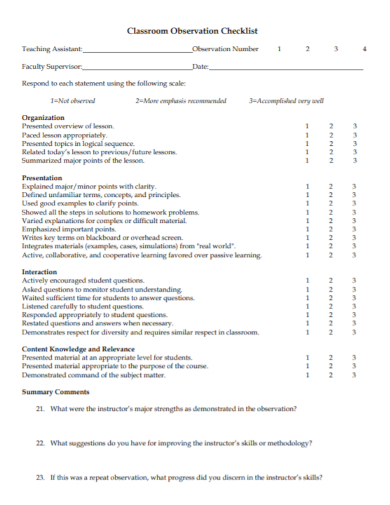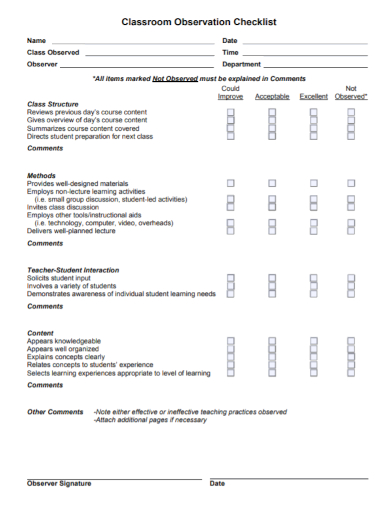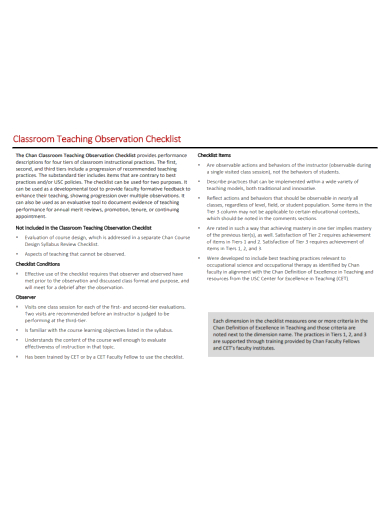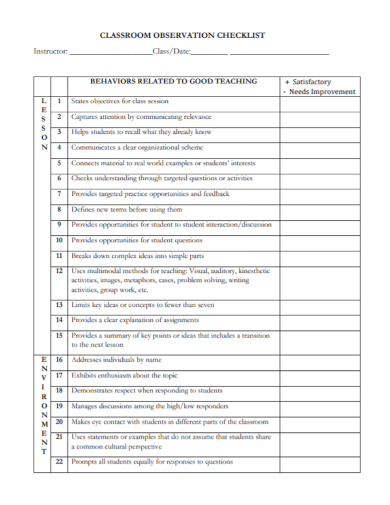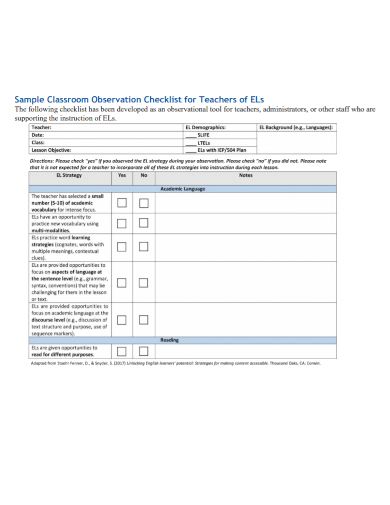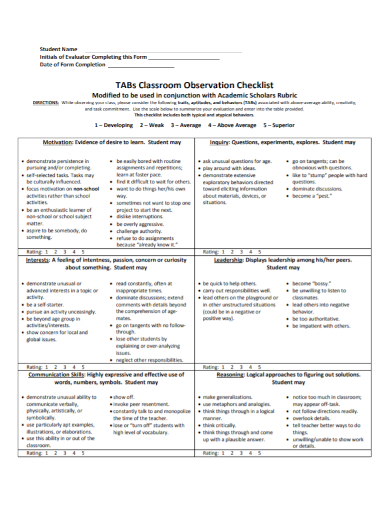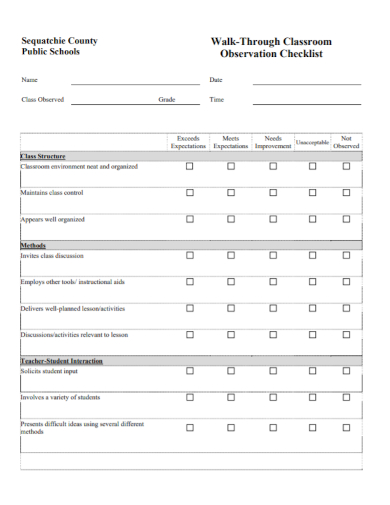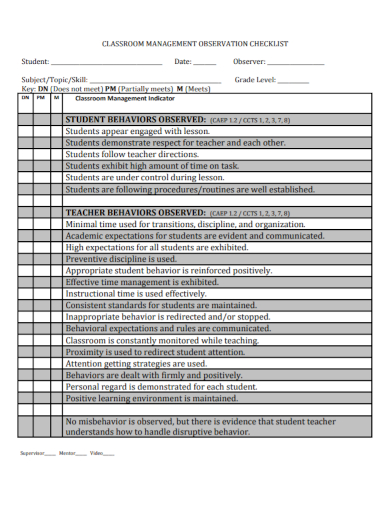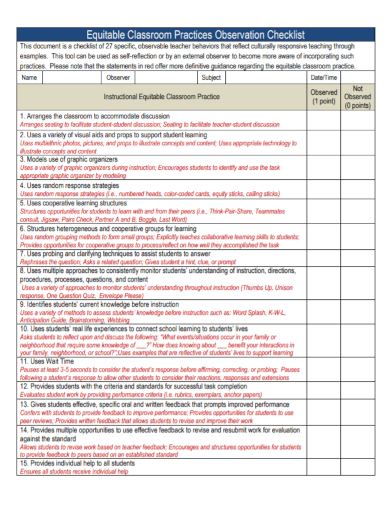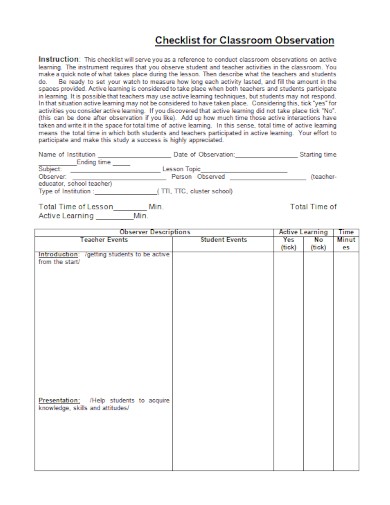Teachers are sometimes being observed and evaluated when they are conducting classes to their students to determine how they handle their students in the classroom and how they demonstrate their teaching techniques and to find out if their methods are effective. Observing teachers is not a walk in the park; observing teachers is a technical process and the observant have to follow certain guidelines as their basis on evaluating teachers based on their observation. If you’re starting out as a principal or you’re a teacher assigned to observed your co-teacher and you don’t know how to conduct a classroom observation yet, you need a checklist to serve as your guide. Read the article to find out how to make a classroom observation checklist.
10+ Classroom Observation Checklist Samples
1. Classroom Observation Checklist
2. Sample Classroom Observation Checklist
3. Classroom Teaching Observation Checklist
4. Standard Classroom Observation Checklist
5. Classroom Teacher Observation Checklist
6. Student Classroom Observation Checklist
7. School Classroom Observation Checklist
8. Classroom Management Observation Checklist
9. Equitable Classroom Observation Checklist
10. Classroom Observation Evaluation Checklist
11. Checklist for Classroom Observation
What is a Classroom Observation Checklist?
A classroom observation checklist, or sometimes called a teacher observation checklist, is a tool used by school administrators to evaluate the performance of teachers to ensure that teaching practices are effective and a positive and helpful learning environment is provided for the students.
When observing teachers, the observant must focus on the key areas mentioned below:
- Effective Planning: This aspect incorporate the preparedness of the teacher in the subject matter.
- Teaching Techniques: This aspect refers to the approach and delivery of the instructor to the subject matter.
- Student and Teacher Relationships: This aspect refers to how the instructor interacts with the students academically.
How to Make a Classroom Observation Checklist
To make the checklist, first, you need a sheet of paper and a pen to draft the checklist. When drafting, follow the guidelines the school has provided to be your basis in evaluating teachers and students in the classroom. However, if there are no guidelines provided, refer to the guidelines mentioned below to include in your checklist. The checklist must have the following elements and its aspects to guide you in giving a good evaluation to the class:
1. Lesson
- The teacher states the class objectives.
- Helps students recall their previous lessons.
- Connects the lessons to real-world examples or students’ interests.
- Checks understanding of the students through targeted questions or activities.
- Breaks down complex lessons to be more understandable for students.
- Gives good feedback to students.
- Provides opportunities for students to interact and discuss with the class.
- Allow students to ask questions.
- Provides a clear explanation of assignments.
- Gives a summary of key points or ideas that includes a transition to the next lesson.
2. Environment
- The teacher addresses students by name and demonstrates respect when responding to students.
- Manages discussions among students.
- Prompts all students equally for responses to questions.
3. Delivery
- The teacher is easily heard and their enunciation is clear.
- Faces the class when speaking.
- Uses friendly gestures and facial expressions.
- Provides explanations for visuals instead of just reading them aloud.
4. Media
- Visual and audio equipment is easily seen and heard.
- Powerpoint slides have minimal text.
- Diagrams, charts, and maps are labeled clearly.
FAQs
How do you do class observation?
To do a proper class observation, do the following tasks:
- Communicate with the teacher
- Provide all necessary documentation for observation
- Provide review and constructive criticism to the teacher
What are the types of observation techniques?
The common types of observation techniques are naturalistic observation, participant observation, structured observation, case study, and archival research.
What are the 6 methods of observation?
The six methods of observation are the testing method, case study method, cross-sectional methods, naturalistic-observation method, laboratory method, and longitudinal method.
After drafting the checklist, make sure to have someone review it (such as your colleague, co-teacher, or the school supervisor, if necessary) to make sure it follows the proper format of a classroom observation and teacher evaluation procedure checklist. Once you officiated the checklist, transfer it into an official-looking document by using a word document to structure your checklist properly. To help get started on making the observation checklist, download our sample templates provided above and use them as your reference!
Related Posts
FREE 16+ Activity Evaluation Form Samples
FREE 16+ Sample Daily Checklists
FREE 10+ Academic Progress Report Samples
FREE 10+ Sample Supply Request Forms
FREE 10+ Tutor Schedule Samples
FREE 10+ Kindergarten Progress Report Samples
FREE 9+ Sample Students Feedback Forms
FREE 9+ Sample Technology Plan
FREE 9+ Functional Behavior Assessment Samples
FREE 8+ Sample Teacher Self-Evaluation Forms
FREE 14+ Sample Physical Education Lesson Plan
FREE 14+ School Schedule Samples
FREE 10+ Summative Evaluation Form Samples
FREE 8+ Music Student Progress Report Samples
FREE 8+ Peer Evaluation Forms

